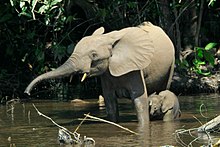Birthing and calves
Gestation in elephants typically lasts around two years with interbirth intervals usually lasting four to five years. Births tend to take place during the wet season. Calves are born 85 cm (33 in) tall and weigh around 120 kg (260 lb).Typically, only a single young is born, but twins sometimes occur. The relatively long pregnancy is maintained by five corpus luteums (as opposed to one in most mammals) and gives the foetus more time to develop, particularly the brain and trunk. As such, newborn elephants are precocial and quickly stand and walk to follow their mother and family herd. A new calf is usually the centre of attention for herd members. Adults and most of the other young will gather around the newborn, touching and caressing it with their trunks. For the first few days, the mother is intolerant of other herd members near her young. Alloparenting – where a calf is cared for by someone other than its mother – takes place in some family groups. Allomothers are typically two to twelve years old. When a predator is near, the family group gathers together with the calves in the centre.
For the first few days, the newborn is unsteady on its feet, and needs the support of its mother. It relies on touch, smell and hearing, as its eyesight is poor. It has little precise control over its trunk, which wiggles around and may cause it to trip. By its second week of life, the calf can walk more firmly and has more control over its trunk. After its first month, a calf can pick up, hold and put objects in its mouth, but cannot suck water through the trunk and must drink directly through the mouth. It is still dependent on its mother and keeps close to her.
For its first three months, a calf relies entirely on milk from its mother for nutrition after which it begins to forage for vegetation and can use its trunk to collect water. At the same time, improvements in lip and leg coordination occur. Calves continue to suckle at the same rate as before until their sixth month, after which they become more independent when feeding. By nine months, mouth, trunk and foot coordination is perfected. After a year, a calf's abilities to groom, drink, and feed itself are fully developed. It still needs its mother for nutrition and protection from predators for at least another year. Suckling bouts tend to last 2–4 min/hr for a calf younger than a year and it continues to suckle until it reaches three years of age or older. Suckling after two years may serve to maintain growth rate, body condition and reproductive ability. Play behaviour in calves differs between the sexes; females run or chase each other, while males play-fight. The former are sexually mature by the age of nine years while the latter become mature around 14–15 years.Elephants have long lifespans, reaching 60–70 years of age.Lin Wang, a captive male Asian elephant, lived for 86 years

No comments:
Post a Comment